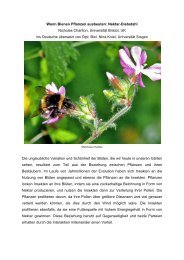PhDâ€theses - Ethologische Gesellschaft
PhDâ€theses - Ethologische Gesellschaft
PhDâ€theses - Ethologische Gesellschaft
Create successful ePaper yourself
Turn your PDF publications into a flip-book with our unique Google optimized e-Paper software.
Research Update<br />
HOME SWEET HOME – THE INFLUENCE OF HOUSING CONDITIONS ON STRESS PHYSIOLOGY,<br />
COGNITION AND EMOTIONAL BEHAVIOUR IN MICE SELECTIVELY BRED<br />
FOR EXTREMES IN STRESS REACTIVITY<br />
Britta Schindler<br />
britta.schindler@gmx.net<br />
Diploma thesis, supervised by Dr. Chadi Touma, Max Planck Institute of Psychiatry, Research Group<br />
of Psychoneuroendocrinology, Kraepelinstr. 2‐10, D‐80804 Munich<br />
It has repeatedly been shown that environmental factors can substantially affect the<br />
phenotype of an individual, including social behaviour, changes of body and organ weight as<br />
well as neuroendocrine parameters. Furthermore, it has been reported that specific brain<br />
regions such as the hippocampus, which is important for learning and memory, are also<br />
influenced by the environment. An ideal system to study these gene‐environment<br />
interactions is to make use of animal models that show a strong genetic predisposition for<br />
certain endophenotypes. Such a model was recently established in our group. This ‘stress<br />
reactivity’ (SR) mouse model consists of three independent mouse lines selectively bred for a<br />
high (HR), intermediate (IR) or low (LR) secretion of corticosterone from the adrenals in<br />
response to a standardised, psychological stressor (15‐min restraint), i.e. showing a hyper‐ or<br />
a hypo‐reactivity of the hypothalamic‐pituitary‐adrenocortical (HPA) axis.<br />
The goal of the present study was therefore to investigate the impact of non‐social<br />
environmental factors such as different housing conditions on specific phenotypes of the SR<br />
mouse model. Of each breeding line, 32 juvenile males were divided into two groups and<br />
kept in groups of four, either under enriched (EN) or standard (ST) housing conditions. In<br />
addition to the bedding and nesting material provided in the ST cages, the EN cages were<br />
equipped with a shelter, a wooden climbing frame as well as with extra bedding and nesting<br />
material. In order to analyse potential differences in the agonistic, socio‐positive and play<br />
behaviour as well as in general activities, we recorded the home cage behaviour of the<br />
animals at three time points (once per week during the first hour of the light phase).<br />
Furthermore, we monitored the body weight of the animals, food intake and coat status to<br />
document the welfare of the animals as well as changes in energy metabolism. After<br />
exposing the animals for six weeks to the respective housing conditions, they were subjected<br />
to a battery of behavioural tests assessing their emotionality, including explorative drive<br />
(open field test, OF), anxiety‐related behaviour (elevated plus‐maze test, EPM) and stress<br />
coping behaviour (forced swim test, FST). Moreover, spatial learning abilities were assessed<br />
in the Y‐maze test and potential effects on HPA axis reactivity were analysed by subjecting<br />
the animals to a ‘stress reactivity’ test (SRT).<br />
The results of our experiment revealed that housing under enriched conditions<br />
influenced several behavioural and neuroendocrine parameters in the SR mouse model.<br />
Compared to ST housed animals, EN housed mice of all three lines showed a higher variety<br />
of behaviours performed in the home cage and significantly less agonistic interactions were<br />
observed. This coincided with decreased corticosterone levels in HR‐EN mice immediately<br />
before the SRT, although the corticosterone response to the stressor was not influenced and<br />
the characteristic HPA axis reactivity differences between HR, IR and LR mice persisted in<br />
both housing conditions. Similarly, stress coping behaviour in the FST was modified towards<br />
more active coping under EN housing conditions (more ‘struggling’ in IR mice and less<br />
18



